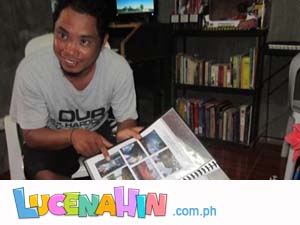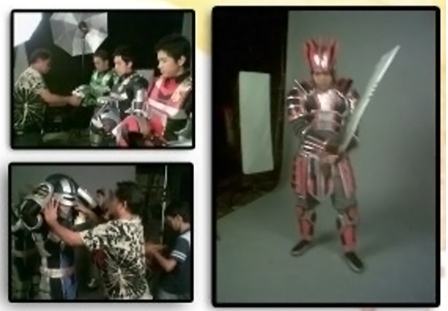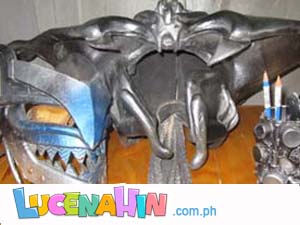Blankets, buckets, cords, and wooden sticks — if this combination means anything to you, it’s probably because, like us, you once donned this costume in your life and imagined yourself to be some caped hero of justice who has finally arrived to save the day.
Looking back, we might have looked a little silly wearing that improvised costume, but hey, we did what we could with the limited skills we had, right? It’s not like we’re professional costume designers who can whip out awe-inspiring costumes with a few cuts here and a few knots there just like Gilbert Edjan.
Who is Gilbert Edjan?
Gilbert Edjan is a professional costume designer who has been making costumes for both television series and full-length movies for several years now. A friend mentioned him during a casual conversation and we got curious about the work he does, so we decided to drop by at their house in University Village to check out some of his works.
Below are some excerpts from the interview we had with him.

Gilbert Edjan showing us an album containing photos of some of the projects he and his teammates have worked on.
We heard you’re a costume designer. Can you tell us what a costume designer does?
As costume designers, our main job is to design and make costumes for actors and actresses, but depending on the requirements of the project, we may also make props and work on stage design. If the art department is short-staffed, we are occasionally asked to do layouts and create additional graphics as well.
When we refer to someone as a costume designer, does it mean they only design the costume or are you also the one who makes it?
It depends on the demands of the project. For big projects, the production designer would give us the overall theme of the project, then the master props man or head designer would make the sketches. Once the sketches are done, they would be forwarded to us so we can start making the actual costumes and sets. For low budget productions, we usually do everything from the conceptualization up to the actual production.
Did you have any formal training in costume and set designing?
No, I didn’t. I wanted to take up Bachelor of Fine Arts before, but they didn’t have it at the university where I graduated from, so I had to learn everything I know now from experience. Luckily, I met some really talented people from my days in a theatre troupe and a Parish Youth Committee, and they taught me a lot of things that have been very useful in my work. I actually met the people who introduced me to this profession from those groups.
What kind of materials do you usually use for the costumes you make?
Back in the early days, we used to use fiberglass; however, working with it can get a bit complicated — not to mention costly — so we experimented with possible alternatives while working on the costumes for Mulawin the Movie. We heard of this material called crepe sole – the same material used for the sole of sneakers – so we gave it a try. At first, working with it was a bit tricky because the outputs tend to look a bit flat, but after some experimenting, we figured out how to make the costumes bulkier. We’ve been using it since then.
Other than those two, we also use Styrofoam, PVCs, plywood, and aluminum. It all depends on what the job requires.
Would you mind sharing some of the projects that you worked on with us?
We made the costumes for the cast of Zaido, Dyesebel, Kamandag, Atlantika, and Ronin. We also did the set, costumes, and props of Captain Barbell, Encantadia, and Etheria. As for movies, we worked on the costumes of the cast of Mulawin the Movie and the costumes and props worn and used by the cast of Resiklo.

Photos showing the different costumes and props that Gilbert Edjan and his team made for the GMA primetime series Zaido.
Which of the projects that you’ve worked on do you consider to be the most difficult?
Probably Zaido. It was difficult because the costumes came in different colors. We had to coat each individual slice of rubber with leather (to give it some color) before we glue them together, so it took a lot of work. Also, we were only given a 2D sketch of the costume they wanted us to make. We had no idea how the back and the sides would look like, so we had to use our imagination.
Do you have any memorable experiences from being a costume designer?
There’s this one time when we were tasked to take care of the original Captain Barbell costume. That costume cost more than a million pesos, so all throughout the time it was with us, we were scared to touch it because we cannot afford to damage it.
There were also those awkward situations when we had to borrow the tops of some of the actresses so we could take their measurements for the costumes we’re going to make. Of course, it’s nothing personal, but broaching the subject can be a bit embarrassing. It’s a good thing that they understood.
Sometimes, we’ll also be cast as extras when there aren’t enough talents, so I’ll ask my relatives to check me out. They would then ask me, “Where are you? I can’t see you,” and I would point out, “There, the one with the mask!” Haha!
What do you consider to be the most important lesson that you’ve learned from your job?
Working under pressure. We work in a fast-paced environment, so you need to be flexible in order to cope with crazy schedules and unexpected changes. It can be tough at times, but it helped us do things that we wouldn’t have thought we’d be able to do before.
Thanks to my work, I also learned to work with people with different personalities. I think that helps a lot because no matter what your line of work is, maintaining a good professional relationship with your clients is always a must.
What’s the best thing about being a costume designer?
Being able to push your limits. Sometimes, we’d be given a project and we’d have no idea how we’d do it. We would then start experimenting with different materials and techniques, and before we know it, we’re done.

From left to right: a mask worn by a villain in Zaido, a headdress worn by a villain in Atlantika, and a pen holder made from recycled materials made by Gilbert Edjan.
What about the most difficult?
Time constraints and limited budgets. Sometimes, they’ll ask us to work on elaborate props and costumes within a short amount of time, so we’d be working on the double with little time to sleep or rest. On some occasions, the budget would be a bit too stretched, so we’d have to manage with a small team of 3-4 people doing the work of a much larger group.
Aside from making costumes and props, do you also dabble in other artistic fields?
When I’m not working on sets or costumes, I also paint portraits and murals. I also do woodwork, comic strips, and layouts. Occasionally, I also compose songs and jingles, two of which were used by Rugis band and the Liberal Party during the campaign of President Noynoy Aquino. You can see some samples of the work I do on my Facebook account.
What tips or advice can you give to people who are also interested in becoming a costume designer like you?
Passion is important in this kind of work. You’ll have a hard time learning the ropes if you’re just forcing yourself to do this. You won’t learn everything in one night, so be patient and don’t be afraid to make mistakes. That’s part of the learning process. When you do learn something new, try to share it with others. Don’t be selfish. You also owe what you know to artists before you, so it’s your turn to pay it forward. That way, you’re not only helping budding artists hone their talents, you’re also leaving a legacy behind.

 Philippine Peso
Philippine Peso